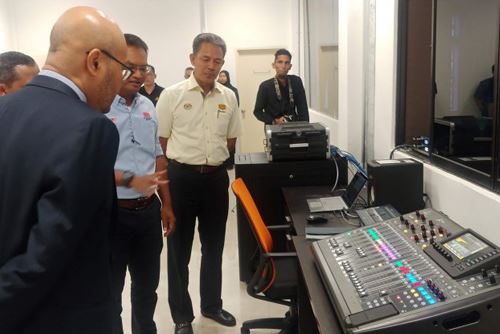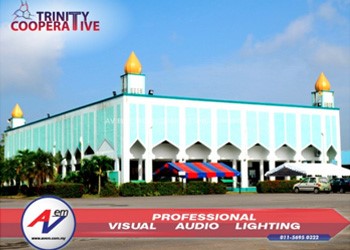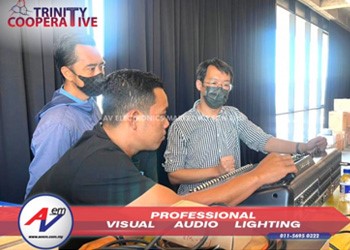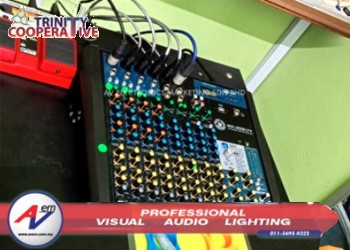AVEM Classroom 05 - Sound Waves & Wavelengths
This chapter covers the basics of sound propagation, sound wave frequency and wavelength, harmonics, the decibel, and the sound environment. It examines how these basics apply to the electrical pathway used to process sound. We will review the analog electrical audio-signal chain from start to finish—from microphones to loudspeakers—and discuss the various signal levels, the cables used, and the types of circuits that are preferred for prossional audio.

Sound Waves
Sound is the result of waves of compression moving through a compressible medium such as air or water. The vacuum of space is not a compressible medium—that's why nobody can hear you scream.
The compression waves are generally caused by vibrations from an object such as a plucked string. a set of vocal chords, a loudspeaker, a tuning fork, a hammer hitting a nail, or even a cicada scratching its back legs together. Each movement of the vibrating object moves the medium around it, radiating alternating waves of compression followed by rarefication (decompression). Compression waves can also be caused by movements in the medium itself, such as wind blowing, a flute being played, or air escaping from a cooling vent.
A simple way to visualize these sound waves is to think of what happens when you drop a rock into a pool of water. The rock creates a disturbance by displacing water molecules—compressing them to create a raised up wave, which then travels outward in the pool. As the wave peak travels, it leaves behind it an area of rarefication in the form of a trough, which in turn leaves behind it an area of rarefication, which in turn leaves behind it in an area of compression, and so on. What we see is a series of concentric rings of peaks and valleys (compresions and rarefications) traveling outward from the point where the rock struck to describe waves.
- Wavelength or frequency (which are directly correlated)
- Amplitute (height)
Wavelength
Wavelength is the distance between two points that occur at the same place in a cycle. If you select any point on the wave shown in Figure 4-1, the wavelength is the distance to the identical point on the next cycle.
The central horizontal line is the zero-reference line or refererance level, which represents the molecule at their rest position. The parts of the sine wave above the reference level represent molecules being separated (rarefaction).
A complete cycle has taken place when the molecules have moved from their rest position, though compression, then rarefaction, and back to their position.

The wavelength of a sound wave is dependant on its speed of transmission through the compressible medium. For air, the speed of sound at sea level, at a temperature of 20°C(68°F), is 343 meters per second (m/s) (1,125 feet per second).
- active loudspeaker
- active speaker
- active subwoofer
- alto
- analog crossover
- analog equalizer
- analog mixer
- audiocenter
- b205d
- behringer
- bmb
- bosch
- box speaker
- church
- column speaker system
- convention center
- csp-610
- csp612
- css1720
- csw-115
- da2250
- da2500
- dad-500
- dad950
- dar-350h
- dcx2496le
- digital loudspeaker management
- digital mixer
- digital snak2
- digital snake
- dl16
- dlm408plus
- dm220
- dm24.8
- dm-24.8
- dm48.20
- dpe-2.10
- dpm4.13mk2
- dsp5211
- dsppa
- dsspa
- dvs-4t
- ea5118
- education
- emix
- emma-120b
- emma-835zsmkll
- empa-8250mkii
- empa-8500
- empa-8500 mkii
- empa-8500mkll
- emws884
- emws884b
- emws-884w
- ep1500
- ep2000
- ep512
- fbq-1502
- fbq-1502hd
- fbq3102hd
- hm1461fx
- hm822fx
- ic electronics
- iq15
- iq18b
- iva
- iva audio pack
- karaoke
- kfc
- kla210
- kla210dsp
- kla210wp
- kla218
- kla218dsp
- kla28
- kla815b
- klark teknik
- km1700
- l65
- l65+l65a
- l65+l65s
- l65a
- lbb-3200/00
- lbc-3200/00
- lbc-3210/00
- line array
- live music venue
- live-8
- loudspeaker
- lt10a
- lt12p
- m18b
- m32
- m32 live
- m7.0mkii
- m-7.0mkii
- ma12
- ma15
- masjid
- microphone
- microphones
- midas
- mixer
- mixing amplifier
- mr-28u
- multipurpose hall
- mxi.1222cfx
- mxi.1422
- mxi.1422cfx
- mxi.1622cfx
- my boss club
- pa sistem untuk masjid
- pa system for auditorium
- pa system for bar
- pa system for cafe
- pa system for church
- pa system for court
- pa system for goverment
- pa system for hall
- pa system for hotel
- pa system for mosque
- pa system for multipurpose hall
- pa system for restaurant
- pa system for school
- pa system for temple
- pa system for worship
- passive loudspeaker
- passive subwoofer
- pc260
- pf-118b+wp
- pf-12+wp
- pf-15+wp
- pm827
- pm8270
- pm-8270
- power amplifier
- power mixer
- powered mixer
- pro-12.0
- pro256dx
- pro26dx
- pro7.0
- pro-9.0
- proel
- pro-ud2
- ps15r2
- qx602mp3
- rx10mk2
- rx-10mk2
- rx12mk2
- rx-12mk2
- rx15mk2
- rx-15mk2
- rx-5mk2
- s16
- s32
- sa3118
- sa312
- sa315
- shure
- smaart tuning
- stadium
- stage monitor
- sub118b
- sub-118b
- subwoofer
- t2208
- tannoy
- test test
- tfx122m-an
- th20/tu60ml
- topp pro
- tpm2.3
- tpm-2.3
- tpx-122m
- turbosound
- u2004ch4
- uum
- ux34d
- v4fx
- ve-20
- vp1220
- wd12av2
- wd15av2
- weather proof loudspeaker
- wing
- wireless microphone
- ws740
- x10
- x10a
- x12a
- x15
- x15a
- x1622usb
- x1832usb
- x32
- x32 compact
- x32 producer
- x8
- x8a
- xenyx x1204usb
- xenyx x2442usb
- xr18



















